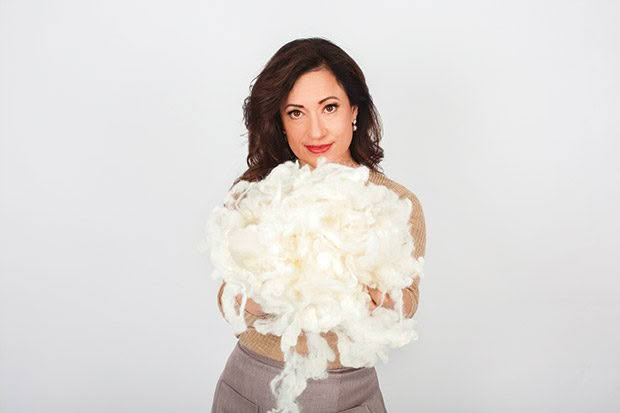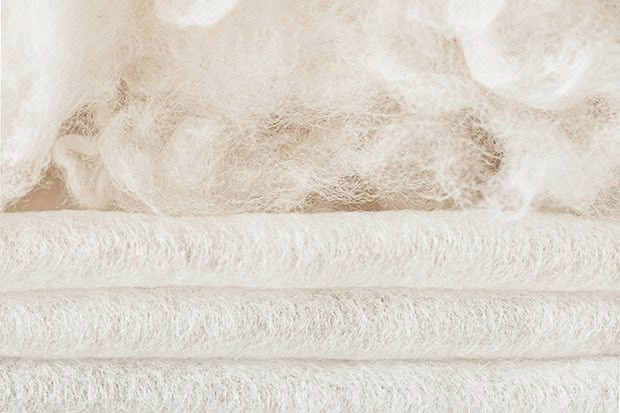How Woolchemy is turning wool into an superhero textile for the nappy industry

A new mum’s dissatisfaction with disposable nappies leads to the birth of a business.
Words: Peter Griffin
It’s an irrefutable fact that the day-to-day life of early motherhood includes dirty nappies. For many, that stirs little other than acceptance of a necessary routine.
But in Derelee Potroz-Smith (above), it created an eco-anxiety attack. “It was when I found there was a cup of crude oil used to make each nappy,” says Derelee, who comes from a family of north Taranaki sheep farmers. She and her mother, Angela Potroz, got thinking about how to tackle the environmental impact of discarded nappies and depressed wool prices.
As a child, Derelee spent many hours in the shearing shed and while her brothers and father shore the sheep, she sorted the wool. “Wool was 50 per cent of my family’s income at one point, and in 1989 it declined to 10 per cent.”

New Zealand’s wool was the best in the world, but it couldn’t compete with the proliferation of synthetic fibres going into carpets and clothing, wound dressings and nappies. Derelee put her problem-solving engineering skills to use in seeking a solution. Woolchemy was born in 2008 to produce natural and biodegradable alternatives to polyester and polypropylene (materials derived from petroleum) in cheap, washable and disposable nappies.
The 300,000 nappies discarded globally every minute mostly go into landfills, and the synthetic fibres they contain can remain in the environment indefinitely. Derelee’s goal was to see wool successfully replace synthetic fibres to keep a baby dry and comfortable. The key was to reverse wool’s natural trait as excellent at repelling liquid. That’s great for hiking clothing, but nappies need a membrane that can quickly absorb a lot of urine.
“Most textile processes coat the fibres with a resin or use toxic chemicals to remove the outer surface of the fibre. But our process alters the molecular structure of the wool fibre with some clever chemistry, and the outcome is still 100 per cent wool but ultra-absorbent,” says Derelee.
The resulting patented product, neweZorb was created in 2015. It’s a washable, reusable textile that can be added to fabrics and garments and disposable products such as nappies. Depending on its application, it can be 25 times as absorbent as untreated wool.

Initially, Derelee aimed to commercialize an entire wool-based biodegradable nappy. But a visit to trade shows exposed her to the fierce competition between the major nappy-makers. “A lot of diaper producers are on the back foot trying to find alternatives to synthetic fibres,” she says. “So, we decided to change our focus to helping them access biodegradable, natural fibres.”
In particular, Woolchemy concentrates on the acquisition distribution layer (ADL), the thin material sandwiched between the top sheet and the absorbent core of a nappy. In 2020, Woolchemy received $200,000 from the Ministry for Primary Industries and industry backers to trial neweZorb with several major nappy-makers. Those trials proved neweZorb’s superior performance to synthetic equivalents.
Derelee sees neweZorb going into premium nappies rather than cheaper store-branded synthetic nappies. The potential uses for Woolchemy’s fibres extend beyond nappies to feminine hygiene pads and wet wipes. An additional MPI grant of $424,000 received in May will allow Woolchemy to experiment with ways of scaling up manufacturing of its new sustainable wool fibre product, neweFlex. The washable, absorbent materials are made in Wellington, with the single-use materials manufactured in Europe.
Woolchemy is pre-revenue, says Derelee, who currently has a team of three. After a long R&D process, she expects to have nappies featuring Woolchemy materials on the market next year. “It takes a lot of work to make not just a sustainable product, but a sustainable business as well,” she says. “Every day on the farm is challenging. I’ve probably taken on those traits in being incredibly stubborn and persistent.”
Headwinds: “By far, the biggest challenge to date has been getting manufacturers to be brave enough to use a completely different fibre other than polypropylene or polyester.”
Tailwinds: “It’s the awareness of climate change and pressure from consumers. At some point, if you are not using sustainable materials, you will be taxed or required to collect and recycle the products.”
What’s next? Building a pilot plant to encourage companies to make products based on Woolchemy’s materials.
NUMBERS
30kg — the amount of carbon dioxide a sheep’s fleece will absorb over its lifetime
US$76 billion — the estimated size of the global baby nappy market in 2020
300,000 — the number of used nappies discarded globally every minute
Love this story? Subscribe now!
 This article first appeared in NZ Life & Leisure Magazine.
This article first appeared in NZ Life & Leisure Magazine.
